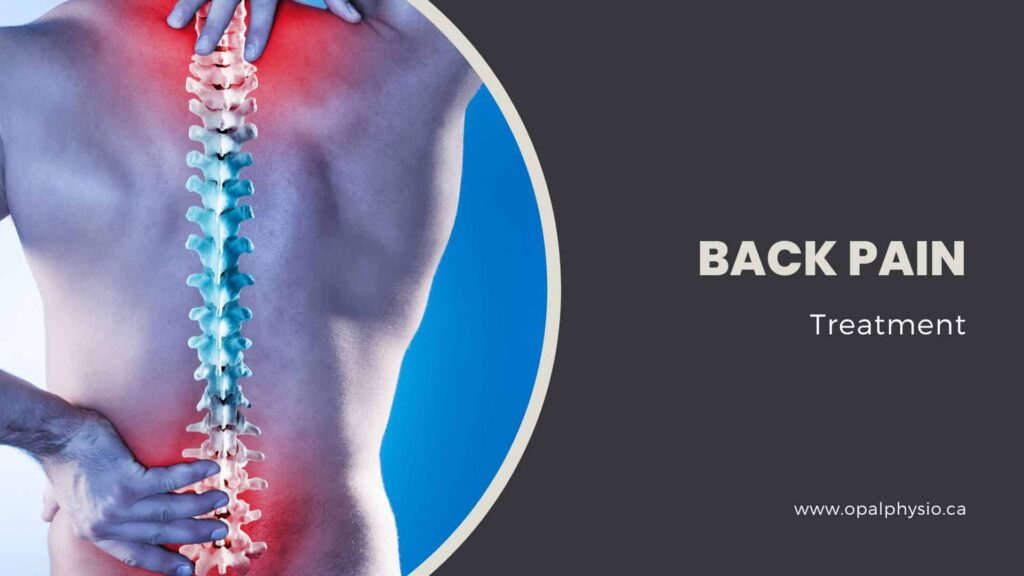Back Pain Treatment in Langley
Back Pain Relief
The back is the most important part supporting the entire body, and back pain is one of the most common conditions people experience. Back pain is one of the most prevalent causes of disability globally, affecting people of all age groups, and it can be chronic or acute.
Physiotherapy treatment helps improve movement and reduce pain in people with back problems. Physiotherapy aims to help you learn how to use your body appropriately again, prevent future movement problems, and reduce pain.
We offer specialized back pain relief physiotherapy services in Langley aimed at helping you find relief from your discomfort and regain optimal function.

There are many different causes of back pain. Some common causes are an injury to the spine, illness, bad posture, infection or a herniated disc. Your back muscles are usually strong to protect your spine from injury when you lift heavy objects or twist at the waist. But when these muscles, including the core, are strained or weak, they may not provide enough support for your spine and can cause backache.
Types of Back Pain
Back pain can be acute, starting suddenly and lasting a few days or weeks, or chronic, lasting months or years. The pain from the back may come from the connective tissue in your back (muscle spasm), joints between the bones in your spine (such as a vertebra, disc, or facet joints), nerves that run through your spine (such as sciatica), or other causes.
Acute back pain: Typically lasts between a few days to a few weeks. It is the most common type of back condition and can be caused by a sudden injury or muscle spasm after lifting anything heavier or from a twisting injury. The most common type is a herniated disc, when one of the discs between two vertebrae ruptures and presses on a nerve causing acute pain.
Sub-acute back pain: Pain lasts four to twelve weeks and is usually caused by ongoing muscle spasms or stiff joints.
Chronic back pain: any pain in the back lasting more than 12 weeks is much more prevalent. It can be caused by an underlying condition such as degenerative arthritis, osteoporosis, ruptured discs, or post-surgical and myofascial pain.
Referred pain: Systemic problems can cause referral pain to the back, for example, kidney stones, pancreatitis, diverticulosis, cancer etc. which could be mistaken for recurring back pain and needs medical attention.
What causes back pain?
Back pain is a common issue that various factors, including mechanical or structural problems, inflammatory conditions, injuries, and other medical conditions, can cause. Here is a list of some common causes of back pain:
It is essential to consult a healthcare professional for an accurate diagnosis and appropriate treatment plan if you are experiencing persistent back pain.
Back pain symptoms
The following are some of the symptoms:
Treatments for back pain:
The treatments available for back pain include

Physiotherapy treatment for back pain
Physiotherapy is an effective treatment for back pain, focusing on improving strength, flexibility, and overall function.
Physiotherapists are knowledgeable in their field and have extensive training in anatomy and physiology. They also understand how muscles work together to move and how injuries affect this process. A physiotherapist can help with back pain in so many ways.
They will assess the individual’s back and any contributing factors. They can recommend exercises, modifications to daily activities, and advice on assistive devices. They will also provide education on self-care techniques and the importance of seeking appropriate medical care from doctors.
Physiotherapy helps relieve pain by improving the function of the muscles and joints. As a result, physio treatment can help to reduce disability and improve the quality of life.
Here are some common physiotherapy techniques and exercises used to treat back pain.
- Heat therapy: Heat can help relax muscles and improve blood flow to the affected area.
- Mobilization: Physiotherapists use gentle movements to increase the range of motion in the spine and surrounding joints.
- Myofascial release: This technique can help relieve muscle tension and improve blood circulation.
- Exercises: Physiotherapists can provide exercises to help relieve the backache and strengthen the muscles. This can include, Brudging, pelvic tilt, knee to chest, back extension etc. Physiotherapists may also recommend aerobic exercises like walking, swimming, or cycling to improve overall fitness and reduce pain in the back.
- Education: Physiotherapists can provide valuable education on back pain management, including proper posture, exercise techniques, and self-care strategies to promote long-term relief and prevent future pain episodes.
It’s essential to consult with a healthcare professional or physiotherapist before starting any new exercise program, especially if you have ongoing pain or have recently experienced a back injury.
Why choose us?
- Experienced Team: Our team of skilled physiotherapists has extensive experience in treating pain conditions.
- Individualized Care: We recognize that each patient is unique, so we tailor our treatments to meet your specific needs.
- Evidence-Based Practices: Our treatments are based on the latest research and proven techniques in physiotherapy.
- Compassionate Approach: We are committed to providing a caring and supportive environment to help you through your recovery journey.
Need Help with your back pain?
Our Physiotherapist at Opal Physio uses the proven McKenzie method for assessing and treating back pain with hands-on manual therapy, mobilization and exercise to help alleviate your pain.
Contact us to book an appointment to help with your back pain. Call us at 604-532-7887 or message us by clicking the link below.
Don’t let pain hold you back from enjoying life. Take the first step towards finding relief by contacting our clinic today. Our dedicated team is ready to assist you in achieving a pain-free and active lifestyle.
